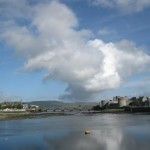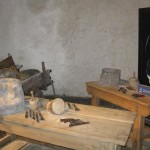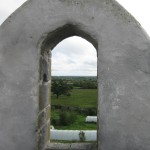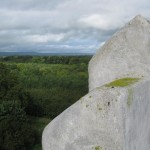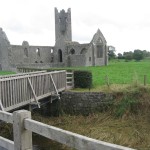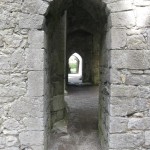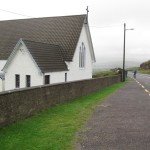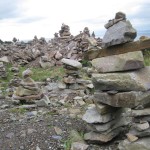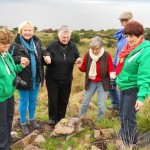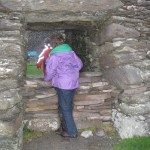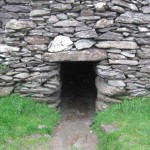These Boots are Made for Walking: Counting Down the Days!
 The founder of Taoism, Lao-tzu, is attributed with saying “The longest journey begins with a single step.” My journey began around 2000 when I was first introduced to the Camino de Santiago by Shirley Maclaine’s book, The Camino. I was intrigued by her accounts of a self-discovery pilgrimage.
The founder of Taoism, Lao-tzu, is attributed with saying “The longest journey begins with a single step.” My journey began around 2000 when I was first introduced to the Camino de Santiago by Shirley Maclaine’s book, The Camino. I was intrigued by her accounts of a self-discovery pilgrimage.
Maclaine wasn’t the first person to travel that Pilgrimage and I won’t be the last. For the last 1000 years, people such as St. Francis of Assisi, Charlemagne, Ferdinand and Isabella, Dante and even Chaucer have taken the journey.
Most people walk the distance in 28 to 42 days. I will be taking my time and staying at least 40 days.
I’ve asked myself several times, “Why am I so interested in walking 500 miles, alone, in a country 4,000 miles away from home?” My Spanish is nonexistent. Almost 50 years ago, I had one year of Spanish in high school.
I’ve always been fascinated with other cultures and travel. I’ve fed that attraction with many trips to numerous countries. I’ve hosted people from several counties and have been a guest of others in foreign lands.
A vivid memory from my early childhood was my owning a book titled The Wanderlust. I don’t know how I acquired it and I don’t remember the plot. I’ve searched on-line, hoping to find a clue to the allure, but haven’t found anything that resembles that particular book.
Why? Could it be something about Maya Angelou’s passage? “Perhaps travel cannot prevent bigotry, but by demonstrating that all peoples cry, laugh, eat, worry, and die, it can introduce the idea that if we try and understand each other, we may even become friends.”
Traditionally, as with most pilgrimages, the Way of Saint James or the Camino de Santiago, begins at home and ends at the final destination site. To me, a pilgrimage is more than just the miles one walks on the actual route. I can attest to the fact that the journey begins at conception by the 8 months I have spent, and the 3 months more that I need, to get ready for this walk; not counting the years that the seed has been germinating in my heart and head. It has already been a journey in and of itself; just the soul-searching alone could be termed a pilgrimage.
I’ve given hours and hours to internet searches and I’ve read several books, including A Pilgrims Guide to The Camino de Santiago by John Brierley, To Walk Far, Carry Less by Jean-Christie Ashmore, Eyewitness Travel ‘s Northern Spain, and one book that was so boring I gave it away and don’t remember the name or author. When The Way came out, a 2010 American film with Emilio Estevez and his father Martin Sheen, I was beside myself with excitement. It was such a small budget, small release film that I missed it in the theatres, but was so happy to buy it on DVD two years ago.
My tickets to Spain, in early May, are ready and waiting. I have a reservation for a two-night stay at a hotel when I arrive in Pamplona, known here for Hemingway and the Running of the Bulls. I’ll need to get over jetlag and I want some time to see the city before I set out on foot.
I’ve gone against my frugal nature of walking around town, several days a week, and have joined the Carroll Wellness Center. I need upper-body strength to carry a 20-pound backpack and have it less burdensome. I’ve followed all the sales at REI and made three trips to Greensboro, the nearest REI store, to reequip my hiking supplies. My boots are 20 years old and the sole is about to come off. Five-hundred miles with less than wonderful hiking boots-I don’t think so!
The main pilgrimage route to Santiago, since the Middle Ages, follows an earlier Roman trade route. There are more than a dozen routes that converge at Saint James’ tomb in western Spain. Many people walk the Way for religious reasons. Many hikers walk the route for non-religious reasons such as travel, sport, or the challenge. Part of my fascination and determination is to experience a spiritual adventure and to distance myself from the hustle and bustle of everyday life. Part of my resolve is to stay as young as possible, both mentally and physically. This segment of my life should provide proof of my mental and physical competences, one way or the other.
The Camino’s accommodations are unique with pilgrim hostels (albergues) which allow pilgrims to sleep in dormitory-style accommodations for as little as €3-10 ($4-14) per night. A good reason to go in May is to avoid the college kids that frequent the trail in the summer months. By all accounts, there are pilgrims of all age groups. Pilgrim menus are served in restaurants and sometimes at the hostels and are reasonably priced to accommodate the cathartic adventure.
To prevent misuse of the 1000-year old spirit of hospitality at the refugios, a stay is limited to those carrying proof of their intentions. One small indication that a person is a perigrino (pilgrim) is the iconic symbol of the scallop shell carried by the traveler. There are many accounts as to why this item is symbolic, but one source suggests the grooves in the shell meet at a single point that represent the various routes traveled, arriving at a single destination: the tomb of James in Santiago de Compostela.
Authentic pilgrims carry a credencial, a pass which gives access to the inexpensive and sometimes free, accommodation. The credencial is stamped at each hostel along the way.
Once you reach the Santiago de Compostela Cathedral, after a ritual visit to Saint James’ tomb, you may present your credencial and petition for a compostela, a certificate of accomplishment, written in Latin, given to pilgrims completing the Way.
How will I feel after spending that many days away from family, away from the familiar? Will I want to take up where I leave off? Will my life ever be the same?
Follow my progress as I blog about this journey at www.penelopesart.com. I also have a pencil and a beautiful new lightweight leather journal that my good friend gave me for the trip in which I will attempt to record my thoughts for later reflections.
Camino de Santiago or Bust!
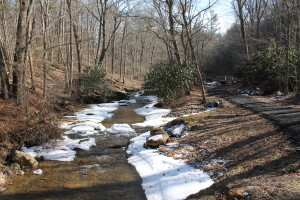 The Beaver Dam Walking Trail slipped on a new pair of waterproof boots.
Thank you to the Town of Hillsville for recognizing the issues of a trail under water and making the much-needed improvements that were recently completed after seven months of work. This is a trail that can, once again, be enjoyed by hikers, birders and nature lovers of all ages. The trail is open every day from sunup to sundown.
I am especially pleased with the improvements at this time in my life. I have spent years getting ready for a pilgrimage of a lifetime. This trail is my answer for preparation of my actual trek in the days leading up to the trip. Traditionally, a pilgrimage begins at home and ends at the final destination site. My destination is a 500-mile spiritual walk across northern Spain, beginning in May, the Camino de Santiago (The Way).
I can attest to the fact that this journey began at conception. I’ve given hours and hours to internet searches, I’ve read several books on the subject, and I’ve reequipped my hiking supplies. I’ve gone against my frugal nature of walking outside on good-weather days and have joined the Carroll Wellness Center. I need upper-body strength to carry a 20-pound backpack.
The Wellness Center’s therapy pool and sauna are great to lessen the stresses of exercising. The modest fees are some of the best money I’ve spent in a long time. However, I have to say that the long walks in town, extended to the Beaver Dam Walking Trail, are even better.
Armed with a camera, water and sandwich, I set out for an easy 6-mile walk on one of the first few pleasing days that Hillsville had experienced this winter. I was pleasantly surprised to have clear blue skies and fifty-degree temperatures instead of rain that had been forecast.
The sidewalks of downtown Hillsville offer a pleasant walk past friendly residents and shopkeepers. For the most part, motorists yield at the right of ways for pedestrians. I started out on South Main Street, where the sidewalk ends, and walked to Rt. 886 or Beaver Dam Road on North Main Street, turned right and walked for 0.5 miles to the northern entrance of the Beaver Dam Trail.
The last time I walked the northern end of the trail, I was knee deep in mud from the damages of flooding and downed trees that severe storms created over the years.
Built originally in 2002, along the Beaver Dam Creek, the 3.32-mile trail is part of the statewide Birding and Wildlife Trail system of the Virginia Department of Game and Inland Fisheries, and is also part of the Mountain Warbler Trail loop.
The contrast of sidewalk to trail, cityscape to nature-scape, and people to animals is psychologically powerful when you drop down the staircase from Beaver Dam Road onto the trail. The creek beside open fields meanders through some riparian habitat. A big portion of the trail is set between tall hills and a canopy of hardwoods. On this particular day, after a rainstorm, birds were chirping loudly and the rushing water was competing with the howling wind.
I spotted deer tracks. That is not so unusual because deer are so abundant in the community that I have to run them out of my backyard on South Main Street. I’m waiting to see the families of wild turkey foraging along the edges of the fields or the frogs and salamanders that are so common in and around the creek.
The switchback of the elevated seven bridges along the trail adds man-made beauty, almost sculptural, with decking and stairs frozen against the ice floats below. The trail on the Upper Beaver Dam is now made of roadway millings. Although lumpy, it is very comfortable to walk on. My waterproof, mid-cut hiking boots, while not necessary, are a good fit to prevent twisted ankles.
There is a new shelter constructed at the trail’s halfway point. I imagine it would be nice if one was caught in a downpour. I enjoy the benches and trashcans dispersed at convenient points along the way. To sit and enjoy a sandwich, listen to nature’s music, and see birds flitting about gives me the energy to finish the journey.
There are no restrooms or porta-potties on the trail, but near the end of the 3.32-miles, you wind past the Carroll Wellness Center. What a relief! Member or not, they will allow you to use their restroom.
After that break, I continued up the steeper part of the trail. I chose this north-to-south route for one reason. Climbing and stopping, climbing and stopping, catching my breath alone in the woods is much better than a south-to-north route where I would be on a public highway, stopping and climbing, stopping and climbing. Someone may see me and think I need an ambulance.
A beautiful part of the trail is paved and in the Carter Pines Community Park that traverses through the towering Carter Pines and by the Carter Hydraulic Water Rams, dating back to 1924 and listed on the National Register of Historic Places. The Rams were built by the Industrialist, George Carter, for his personal use and are preserved by Carroll County. There are several educational way-markers on this short section. Stop, read, and climb. Stop, read, and climb. Perfect for the heart and lungs.
The trail comes out at the rear of the Carroll County Courthouse on the Carroll County Sheriff’s Office side. I caught my breath one last time on the bench of the deck, with a beautiful view of distant mountains, before I hiked on through the parking lot and beside the historic Carroll County Courthouse. I turned left onto Main Street once more.
It was downhill from here. I made it! The third time in as many days, with many, many more treks to come. Next time I’m parking my car at the Carroll Wellness Center and walking to South Main, back to North Main and along the trail for what I’m estimating to be almost 7 miles. I’ll end that hike with a soak in the therapy pool. Thank you Hillsville and all those other donors who have created a wonderful place to lose yourself on a nature trail and to prepare for other, longer travels.
The Beaver Dam Walking Trail slipped on a new pair of waterproof boots.
Thank you to the Town of Hillsville for recognizing the issues of a trail under water and making the much-needed improvements that were recently completed after seven months of work. This is a trail that can, once again, be enjoyed by hikers, birders and nature lovers of all ages. The trail is open every day from sunup to sundown.
I am especially pleased with the improvements at this time in my life. I have spent years getting ready for a pilgrimage of a lifetime. This trail is my answer for preparation of my actual trek in the days leading up to the trip. Traditionally, a pilgrimage begins at home and ends at the final destination site. My destination is a 500-mile spiritual walk across northern Spain, beginning in May, the Camino de Santiago (The Way).
I can attest to the fact that this journey began at conception. I’ve given hours and hours to internet searches, I’ve read several books on the subject, and I’ve reequipped my hiking supplies. I’ve gone against my frugal nature of walking outside on good-weather days and have joined the Carroll Wellness Center. I need upper-body strength to carry a 20-pound backpack.
The Wellness Center’s therapy pool and sauna are great to lessen the stresses of exercising. The modest fees are some of the best money I’ve spent in a long time. However, I have to say that the long walks in town, extended to the Beaver Dam Walking Trail, are even better.
Armed with a camera, water and sandwich, I set out for an easy 6-mile walk on one of the first few pleasing days that Hillsville had experienced this winter. I was pleasantly surprised to have clear blue skies and fifty-degree temperatures instead of rain that had been forecast.
The sidewalks of downtown Hillsville offer a pleasant walk past friendly residents and shopkeepers. For the most part, motorists yield at the right of ways for pedestrians. I started out on South Main Street, where the sidewalk ends, and walked to Rt. 886 or Beaver Dam Road on North Main Street, turned right and walked for 0.5 miles to the northern entrance of the Beaver Dam Trail.
The last time I walked the northern end of the trail, I was knee deep in mud from the damages of flooding and downed trees that severe storms created over the years.
Built originally in 2002, along the Beaver Dam Creek, the 3.32-mile trail is part of the statewide Birding and Wildlife Trail system of the Virginia Department of Game and Inland Fisheries, and is also part of the Mountain Warbler Trail loop.
The contrast of sidewalk to trail, cityscape to nature-scape, and people to animals is psychologically powerful when you drop down the staircase from Beaver Dam Road onto the trail. The creek beside open fields meanders through some riparian habitat. A big portion of the trail is set between tall hills and a canopy of hardwoods. On this particular day, after a rainstorm, birds were chirping loudly and the rushing water was competing with the howling wind.
I spotted deer tracks. That is not so unusual because deer are so abundant in the community that I have to run them out of my backyard on South Main Street. I’m waiting to see the families of wild turkey foraging along the edges of the fields or the frogs and salamanders that are so common in and around the creek.
The switchback of the elevated seven bridges along the trail adds man-made beauty, almost sculptural, with decking and stairs frozen against the ice floats below. The trail on the Upper Beaver Dam is now made of roadway millings. Although lumpy, it is very comfortable to walk on. My waterproof, mid-cut hiking boots, while not necessary, are a good fit to prevent twisted ankles.
There is a new shelter constructed at the trail’s halfway point. I imagine it would be nice if one was caught in a downpour. I enjoy the benches and trashcans dispersed at convenient points along the way. To sit and enjoy a sandwich, listen to nature’s music, and see birds flitting about gives me the energy to finish the journey.
There are no restrooms or porta-potties on the trail, but near the end of the 3.32-miles, you wind past the Carroll Wellness Center. What a relief! Member or not, they will allow you to use their restroom.
After that break, I continued up the steeper part of the trail. I chose this north-to-south route for one reason. Climbing and stopping, climbing and stopping, catching my breath alone in the woods is much better than a south-to-north route where I would be on a public highway, stopping and climbing, stopping and climbing. Someone may see me and think I need an ambulance.
A beautiful part of the trail is paved and in the Carter Pines Community Park that traverses through the towering Carter Pines and by the Carter Hydraulic Water Rams, dating back to 1924 and listed on the National Register of Historic Places. The Rams were built by the Industrialist, George Carter, for his personal use and are preserved by Carroll County. There are several educational way-markers on this short section. Stop, read, and climb. Stop, read, and climb. Perfect for the heart and lungs.
The trail comes out at the rear of the Carroll County Courthouse on the Carroll County Sheriff’s Office side. I caught my breath one last time on the bench of the deck, with a beautiful view of distant mountains, before I hiked on through the parking lot and beside the historic Carroll County Courthouse. I turned left onto Main Street once more.
It was downhill from here. I made it! The third time in as many days, with many, many more treks to come. Next time I’m parking my car at the Carroll Wellness Center and walking to South Main, back to North Main and along the trail for what I’m estimating to be almost 7 miles. I’ll end that hike with a soak in the therapy pool. Thank you Hillsville and all those other donors who have created a wonderful place to lose yourself on a nature trail and to prepare for other, longer travels.
Poetically Limerick
- River Shannon with King John’s.
- Walk by the River.
- Walk by the River.
- Typical Ireland and Potatoes.
- Man-hole cover.
- Interesting brick buildings.
- St Mary’s Cathedral
- Graveyard outside.
- Street musicians with a fiddle.
- Interesting doors.
- Interesting bike.
- The corner to remember getting out of town.
- Hunt Museum.
- Carol in charge.
- Everyone had a job.
- The two guys broke the ice maker. Go figure!
- Lynn calling home for news.
- After dinner web searching.
Thatched-Roof Fairyland
 The day started with a leisurely breakfast around the huge pine table built for an army. The kitchen in the East Tower continued to serve as our gathering place, morning, noon or night. This morning the kitchen table was an exceptionally nice place to gather. Elvis (the previously no-name peacock who lost his mate the month before) was greeting us at the backdoor as if to say, “Hey you guys! I’m part of this party too, you know!” The sun was shining brightly, a welcoming sight. Everyone took their time getting up and about this morning; all of us were still recovering from the previous full day of driving around the Ring of Kerry.
Our schedule called for a drive around the Dingle Peninsula, but a committee suggestion with a unanimous vote called for a day of exploring the towns closer to the castle. We chose to see Kilmallock, only thirty minutes away and then to drive a short distance north and see Adare before making our way back to the castle.
Because the day was sunny and warm we took the opportunity to climb to the roof of the East Tower in Springfield Castle. By this time John and Pat were used to climbing three stories to their room, Harriet and Rob two stories, but the rest of us were intrigued by the beautiful staircase and were anxious to climb that last stepladder. It really was a stepladder, not really steps and much more substantial than a ladder. The view up top was spectacular! Camera-clicking battled with bird-chirping.
The day started with a leisurely breakfast around the huge pine table built for an army. The kitchen in the East Tower continued to serve as our gathering place, morning, noon or night. This morning the kitchen table was an exceptionally nice place to gather. Elvis (the previously no-name peacock who lost his mate the month before) was greeting us at the backdoor as if to say, “Hey you guys! I’m part of this party too, you know!” The sun was shining brightly, a welcoming sight. Everyone took their time getting up and about this morning; all of us were still recovering from the previous full day of driving around the Ring of Kerry.
Our schedule called for a drive around the Dingle Peninsula, but a committee suggestion with a unanimous vote called for a day of exploring the towns closer to the castle. We chose to see Kilmallock, only thirty minutes away and then to drive a short distance north and see Adare before making our way back to the castle.
Because the day was sunny and warm we took the opportunity to climb to the roof of the East Tower in Springfield Castle. By this time John and Pat were used to climbing three stories to their room, Harriet and Rob two stories, but the rest of us were intrigued by the beautiful staircase and were anxious to climb that last stepladder. It really was a stepladder, not really steps and much more substantial than a ladder. The view up top was spectacular! Camera-clicking battled with bird-chirping.
- The staircase in the East Tower.
- Beyond the walls.
- Come on up!
- The view of the gournds.
- Was this for a bell?
- Harriet and Rob in a Kodak moment.
- Another view of the courtyard.
- Another beyond the walls shot.
- I want in on the action.
Ring Around Authentic Ireland


 The route from our castle took us through Killorglin. As we crossed the bridge over the River Laune, I saw a beautiful bronze sculpture of a goat. He was no ordinary goat. He was a Billy Goat standing tall, with handsome horns, guarding the entrance to the town. We had not planned on stopping in this town. We hadn’t actually reached the Ring of Kerry. We crossed the beautiful rock bridge with Roman arches and were taken away with the beauty of the town. The colors of the buildings, set side by side, up and down the steep streets said, “Stop and visit! You’ll love it here!” So stop, we did.
By that time of the morning, we were all ready for a second cup of coffee and a scone. We sat a time to meet back at the parking lot and all went our merry way. Well, almost. I saw a sign on a building off the parking lot, “Killorglin Men’s Shed”. I was intrigued. I approached the shed and a very pleasant, friendly MAN stepped outside the door. He was too friendly to be barring me from entering, so enter, I did. The whole entourage came along. We were all intrigued. The gentleman gave us a tour of the facility and explained the concept. It was ingenious. The shed was filled with woodworking tools and the men paid a membership fee each month to be able to use the shed with its well-appointed assortment of tools. Tools are expensive. Sheds to work in are limited. Sharing the expenses and the camaraderie and learning from each other is a perfect solution. I think this is a concept that should be copied and opened up to women. This was a chance happening that we all enjoyed.
We scattered around town to shop for another few minutes. I stopped at the fruit and veggie stand to get the fixings for tomorrow morning’s omelets. I stood there under the blue-tarp roof feeling very comfortable reading the signs for the produce. Normally when shopping in counties in Europe and now Ireland I’m busy in my head converting pounds to kilograms and Euros to dollars. It dawned on me! These signs were written both ways. The farmer told me that when Ireland converted to the metric system, formally in 1993, that many of the older population didn’t like the new system and he had always measured the fruit and veggies either way. I was impressed at how quickly he made those conversions in his head. Wish my math were as easy for me. I suppose if I did it every day and several times a day, it would be easier.
The route from our castle took us through Killorglin. As we crossed the bridge over the River Laune, I saw a beautiful bronze sculpture of a goat. He was no ordinary goat. He was a Billy Goat standing tall, with handsome horns, guarding the entrance to the town. We had not planned on stopping in this town. We hadn’t actually reached the Ring of Kerry. We crossed the beautiful rock bridge with Roman arches and were taken away with the beauty of the town. The colors of the buildings, set side by side, up and down the steep streets said, “Stop and visit! You’ll love it here!” So stop, we did.
By that time of the morning, we were all ready for a second cup of coffee and a scone. We sat a time to meet back at the parking lot and all went our merry way. Well, almost. I saw a sign on a building off the parking lot, “Killorglin Men’s Shed”. I was intrigued. I approached the shed and a very pleasant, friendly MAN stepped outside the door. He was too friendly to be barring me from entering, so enter, I did. The whole entourage came along. We were all intrigued. The gentleman gave us a tour of the facility and explained the concept. It was ingenious. The shed was filled with woodworking tools and the men paid a membership fee each month to be able to use the shed with its well-appointed assortment of tools. Tools are expensive. Sheds to work in are limited. Sharing the expenses and the camaraderie and learning from each other is a perfect solution. I think this is a concept that should be copied and opened up to women. This was a chance happening that we all enjoyed.
We scattered around town to shop for another few minutes. I stopped at the fruit and veggie stand to get the fixings for tomorrow morning’s omelets. I stood there under the blue-tarp roof feeling very comfortable reading the signs for the produce. Normally when shopping in counties in Europe and now Ireland I’m busy in my head converting pounds to kilograms and Euros to dollars. It dawned on me! These signs were written both ways. The farmer told me that when Ireland converted to the metric system, formally in 1993, that many of the older population didn’t like the new system and he had always measured the fruit and veggies either way. I was impressed at how quickly he made those conversions in his head. Wish my math were as easy for me. I suppose if I did it every day and several times a day, it would be easier.
- Farmers Market-Metric or Imperial
- Angie likes this place too.
- Work from the shed.
- Patterns.
- An assortment of tools.
- What a mess! LOL
- Our gracious guide.
- Is this from Goldilocks?
- Not much of a view.
- What artistic skill!
- Gathering stones.
- Our prayer cairn.
- Fiona!
- Charlie Chaplin.
- Mural of Charlie Chaplin.
- The valley along the drive to the ringfort.
- Sheep grazing on the outside.
- Squeezing through the opening.
- Inside at the designated points.
- Getting dark. Time to go.


